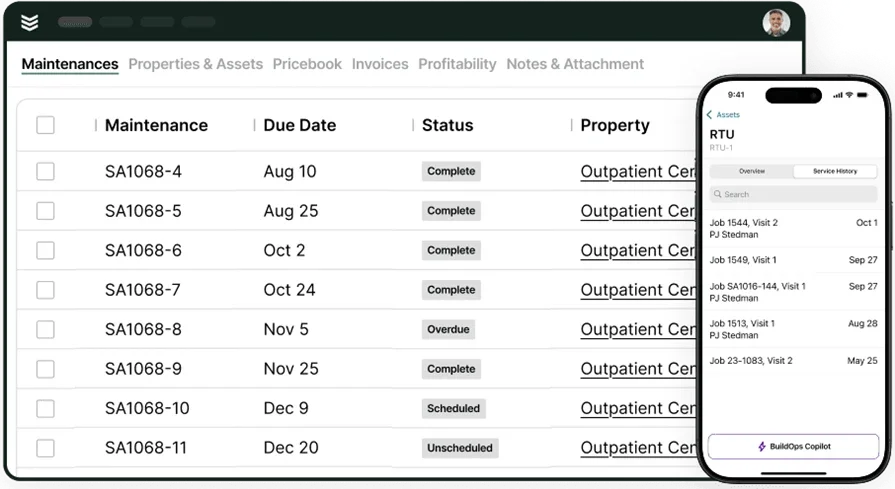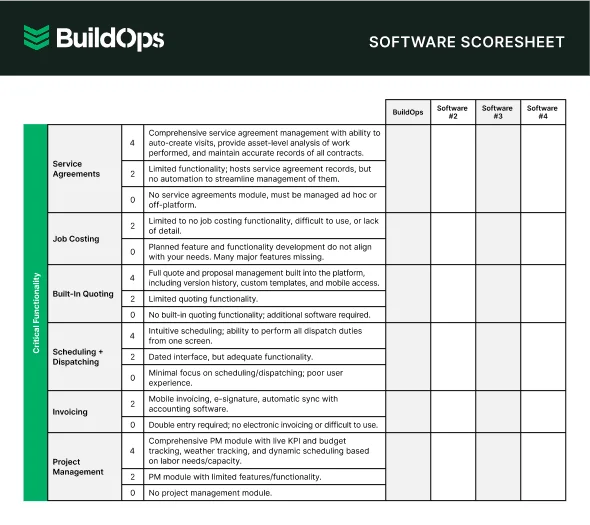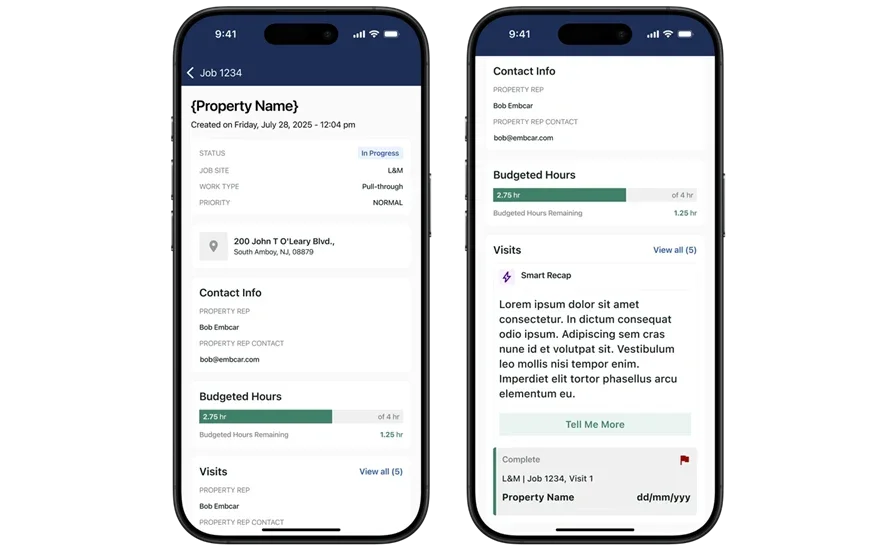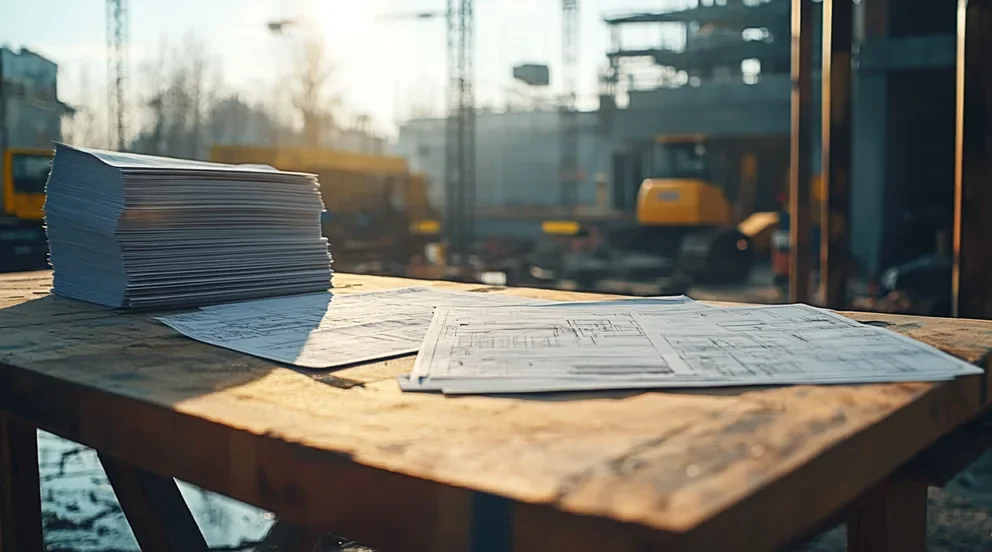Paperwork at the job site can stall a day. JSAs, daily logs, RFIs, T&M tickets, safety checklists. Each document needs quick capture, a signature, and clean storage without sending techs back to the office. A strong construction forms app lets crews fill forms on a phone or tablet, attach photos, and submit with confidence.
The best tools also connect to field service management so every form ties to jobs, assets, and schedules in one workflow. Whether your team handles ground-up builds, installs, maintenance, or repair, the target stays the same: finish documentation on-site and keep work moving.
- Choosing the best construction forms app
- 6 key features to look for in a contractor forms app
- Types of construction forms apps
- 6 best contractor forms apps for field work
- 5 benefits of using construction forms apps
- 4 important construction forms app FAQs answered
Let’s set the foundation. What makes a contractor forms app a solid fit for field teams? Speed in the field, dependable offline capture, clean handoffs to dispatch and accounting, and flexible templates that match how crews work on real jobs.
Up next, we start with how to choose a construction forms app that helps techs wrap paperwork on-site while the office gets organized, and searchable records.
Choosing the best construction forms app for your team
Crews bounce between slab pours, rooftop units, inspections, and punch walks. The construction forms app you choose has to keep pace with that rhythm. The goal stays simple: close documentation at the point of work, capture defensible evidence, and hand structured data to dispatch, safety, and accounting without retyping. Use these questions to pressure-test any contractor forms app during pilots and live jobs.
- Speed in the field – Can a gloved thumb submit a JSA, daily log, or T&M in under a minute? Can foremen prefill from job templates and reuse yesterday’s crew list? Do common actions take two taps or less?
- Readability and inputs – Do screens stay visible in sun and dust? Are tap targets large enough for PPE and checklist items? Can techs dictate notes or snap photos without leaving the form?
- Offline and sync – Will forms, photos, and signatures save in shafts and remote sites? Does the app queue and reconcile changes without duplicates? Can you see sync status so no one wonders if a form actually posted?
- Template governance and compliance – Can admins lock corporate templates by project type? Can you force required fields and drive conditional logic by trade or phase? Can version updates roll to every device without side loading?
- Data flow and approvals – Does the contractor forms app pull job numbers, assets, and cost codes from dispatch? Will it push PDFs and structured data back to the job and accounting with no retyping? Can you route step approvals with alerts and an audit trail that satisfies GC and safety reviews?
- App features – Do you get photo markup and annotations? Do barcode or QR scans, signature capture, batch submit, role permissions, fast PDF output, CSV export, and actionable dashboards come standard?
Put each vendor through a week of field trials and score the answers, not the brochure. If a construction forms app clears these checks under real site conditions, it deserves a spot on your shortlist. Next, we break down the six key features to look for in a contractor forms app so you can compare options with confidence.
6 key features to look for in a contractor forms app
A strong construction forms app becomes part of field work, not a side task. With crews moving between ground-up, tenant improvements, installs, maintenance, and repair, the app has to capture clean data at speed and feed the rest of your system. Here’s what pros look for.
1. Mobile-first capture that works anywhere
The app should open fast, work cleanly on phones and tablets, and keep techs in one screen while they add photos, notes, and signatures. Offline save is nonnegotiable. When signal returns, everything should auto-sync without duplicates. A capable technician mobile app helps crews complete JSAs, daily reports, RFIs, and T&M tickets at the point of work, then produce a polished PDF for the job file.
2. Built-in quoting and change order support
Scope shifts mid-install. Your contractor forms app should let a tech flag changes on a form and spin a priced quote or change order without retyping. Tie line items to materials, labor, and cost codes so PMs see impact instantly. Linking forms to a construction quoting solution keeps approvals tight and traceable.
3. Integrated signatures and payment collection
Close the loop on site. Capture customer, GC, and inspector sign-offs on the device, with time and GPS stamps for disputes. Tie forms to invoicing and payment processing to convert work to an invoice and take card or ACH on completion, including deposits or partials when scope shifts.
4. Smart scheduling and dispatch integration
Forms should know the job they belong to. Pull site, asset, PM, and cost codes from scheduling or your construction dispatch software, then push completed PDFs and data back to the work order. Auto-attach required JSAs, daily reports, or inspections by job type so techs see a clear to-do list at arrival.
5. CRM and asset history tracking
Forms become smarter when tied to customer and equipment records. With a connected construction CRM, techs can see past inspections, warranty notes, and prior deficiencies while filling out a checklist. That context cuts guesswork and keeps documentation consistent across sites.
6. Real-time reporting and job costing
Do not wait for month-end to spot risk. Push structured fields from forms into reporting so PMs can see completion rates, open deficiencies, and cost impact now. Pair that with time tracking to connect labor on forms to job costing and percent-complete.
Other useful features for contractor forms apps
These extras tighten daily execution and clean up the paper trail. They connect your construction forms app to fleet data, labor capture, and service schedules so timestamps, approvals, and records stay accurate without extra taps.
- Fleet tracking integration – Sync job movement and arrival times with fleet data to validate timestamps and travel
- Time tracking tools – Capture labor on the form with a built-in time tracking feature so hours post to jobs without a second entry
- Recurring service agreements – Attach required checklists to scheduled visits with a service agreement system for contractors, improving consistency across long-term clients
The type of work you run, the number of crews, and the project mix will shape which path fits best. Next, we’ll look at the types of contractor forms app options available and how each maps to real job scenarios.

Standardize forms across every job
Tie checklists and sign-offs to scheduled visits with BuildOps service agreements.
Types of construction forms apps
Contractors run different playbooks. Some teams focus on ground-up builds, others run large service divisions, many do both. The construction forms app that fits best depends on job mix, crew size, and how you move field data into the office. Here are the main types to weigh.
All-in-one contractor platforms
Everything connects. Forms tie to scheduling, dispatch, CRM, quoting, time, and reporting. Techs complete JSAs, daily reports, RFIs, and T&M on a phone, then the system files PDFs, updates the job, and shares data with accounting. You get approvals, version control, offline capture, and searchable history in one place.
Best for: Commercial HVAC, electrical, plumbing, fire protection, refrigeration, and mechanical firms with multiple crews and strict compliance needs.
Want to see the workflow end to end? This walkthrough of a field service app shows how crews get scheduled, complete required forms on-site, capture approvals, and send clean data into costing and reports.
Standalone field forms builders
These focus on flexible checklists and fast capture. You get templating, conditional logic, photo markup, and signatures with solid offline performance. Exports work, but integrations can take extra effort and admin teams may handle more manual routing.
Best for: Specialty subs and small teams that mainly need mobile documentation and already manage scheduling or costing elsewhere.
Dispatch and field-service add-ons
Some scheduling or work order tools include simple forms. Daily reports and safety checklists attach to the job, which helps adoption and closeout. Customization, analytics, and cross-project reporting can feel limited compared to a dedicated contractor forms app.
Best for: Teams that want basic forms tied to dispatch with minimal setup and a light learning curve.
Choosing a path comes down to how your crews operate on site and how tightly you need forms connected to jobs and costs. Next, we’ll break down the 6 best contractor forms app options that deliver where it counts.
6 best contractor forms apps for field work
Every contractor runs a different playbook, so the best pick depends on how your crews work in the field. Some teams juggle multi-crew commercial jobs. Others handle high-volume service calls. This list highlights tools that go beyond basic checklists to help techs capture clean data, finish approvals, and keep jobs organized.
1. Best for commercial contractors: BuildOps
BuildOps centers everything around the job so forms, photos, and signatures flow straight into scheduling, dispatch, CRM, quoting, and reporting. Crews complete JSAs, daily reports, RFIs, and T&M on mobile, even offline, and the system files PDFs and structured data back to the job and customer history. For a construction forms app that also runs the operation, this covers the full loop from field capture to closeout.
App Type: Cloud-based platform
How Pricing Works: Personalized demos and pricing based on team size and the modules you need
Features Beyond Forms:
- Real-time job tracking with scheduling and construction dispatch software
- In-field payments through payments and billing via invoicing
- Integrated construction CRM and customer history
What Sets it Apart for Contractors: BuildOps connects forms to dispatch, quoting, job costing, and reporting, which fits commercial HVAC, electrical, plumbing, fire protection, refrigeration, and mechanical teams that want one system to run field and office.

See how BuildOps handles construction forms
From phone to file—crews complete forms on-site, and job records update instantly.
2. Best for residential contractors: Kickserv
Image Source: Kickserv
Kickserv suits small residential service teams that want simple scheduling, customer communication, and quick documentation on mobile. Techs can log notes, attach photos, and send updates from the job site with an easy learning curve. It may not be ideal for complex multi-crew compliance, advanced template governance, or deep offline form logic.
App Type: Cloud-based solution
How Pricing Works: Tiered plans based on user count and feature set
Features Beyond Forms:
- Built-in scheduling and appointment tools
- Mobile invoicing for techs
- Integrations with QuickBooks and Stripe
What Sets it Apart for Contractors: A customer portal makes it easy for homeowners to view job details and approve work, which trims back-and-forth. The tradeoff is lighter controls for corporate templates and audits.
3. Best for small service teams: Jobber
Image Source: Jobber
Jobber focuses on fast scheduling, work orders, and simple checklists for service visits. Crews get a clean mobile app to capture notes, photos, and sign-offs, then send updates to the office without extra steps. It may not be the best choice for commercial contractors that need strict safety forms, step approvals, and project-level reporting across many crews.
App Type: Cloud-based solution
How Pricing Works: Tiered pricing by users and features
Features Beyond Forms:
- Route optimization and job scheduling
- Customer reminders and online booking
- QuickBooks integration
What Sets it Apart for Contractors: Easy onboarding and clear mobile workflows help smaller teams move fast. The tradeoff is limited enterprise-grade controls for approvals, versioning, and job cost visibility compared with an all-in-one contractor forms app.
4. Best for home service pros: Housecall Pro
Image Source: Housecall Pro
Housecall Pro targets residential service outfits that want quick scheduling, estimates, and basic on-site documentation. The mobile app keeps techs moving with photo capture, notes, and simple approvals, then pushes updates to the office with minimal training. It may fall short for commercial teams that require strict template governance, offline logic built for large sites, and advanced reporting tied to cost codes.
App Type: Cloud-based solution
How Pricing Works: Tiered plans by user count and selected features
Features Beyond Forms:
- Online booking and schedule management
- In-app estimates and customer notifications
- QuickBooks and payments integrations
What Sets it Apart for Contractors: Clean workflows for residential calls help crews finish fast. The tradeoff is lighter enterprise controls and limited project-level analytics.
5. Best for large residential operations: ServiceTitan
Image Source: ServiceTitan
ServiceTitan delivers a broad platform for high-volume home service, including call booking, dispatch, pricebooks, and mobile forms. Crews can capture checklists and signatures, while managers track performance with dashboards and alerts. It may feel heavy for mid-market commercial contractors that need flexible JSAs, deep project workflows, or faster setup.
App Type: Cloud-based platform
How Pricing Works: Custom quotes based on team size and modules
Features Beyond Forms:
- Call center tools and advanced dispatch
- Pricebook management and sales tools
- Detailed analytics and performance tracking
What Sets it Apart for Contractors: Strong for scaled residential operations that live on phone-intake and scripted tasks. The tradeoff is cost and setup time for teams that mainly run commercial projects.
6. Best for dispatch-heavy service teams: Workiz
Image Source: Workiz
Workiz focuses on fast scheduling, dispatch, and job communications with a mobile app that supports photos, notes, simple checklists, and signatures. Teams get online booking, call tracking, and payments in one place, which helps high-volume service operations move quickly. It may not suit commercial contractors that need strict template governance, deep offline logic, or project-level reporting across multiple crews in a contractor forms app.
App Type: Cloud-based solution
How Pricing Works: Tiered plans based on users and selected add-ons
Features Beyond Forms:
- Built-in phone system with call tracking and automations
- Online booking, estimates, and customer notifications
- GPS and time tracking with route tools
- Card and ACH payment options
What Sets it Apart for Contractors: Strong dispatch and communications keep phones, jobs, and field updates in sync. The tradeoff is lighter enterprise controls and limited complex form capabilities compared with an all-in-one construction forms app.

Compare software at a glance
Find the ideal software for your crew with this easy-to-use scoresheet.
5 benefits of using construction forms apps
A construction forms app pays off in the field and at the office. Here’s what pros gain when crews capture forms on mobile and push clean data into the job record.
1. Tighter schedules and fewer job delays
When forms sit in trucks, schedules slip. Mobile capture gets safety checklists, JSAs, and daily reports submitted on time, so PMs can release holds and keep crews moving. If your team wants a deeper playbook on coordination, this guide to scheduling and dispatching shows how form status links to assignments and closeout.
2. Cleaner handoffs across the work order flow
Forms that attach to the work order cut retyping and “who touched this” questions. Techs submit from the job, the office sees status, and accounting gets complete packets without chasing paper. For a broader view of this handoff, see how work order software for contractors organizes jobs from request to close.
3. Faster approvals and cash collection
Sign-offs captured on-site speed materials releases, change approvals, and billing. Pairing your forms with an estimate and invoice app for contractors helps teams price changes quickly and send clean invoices backed by photos and signatures.
4. Stronger documentation and compliance at scale
GPS, time stamps, and required fields produce defensible records across projects. Subs and GCs can align on the same templates and approval steps, which reduces back-and-forth. If you manage multiple trades, this overview of construction management software for subcontractors explains how documentation supports coordination and audits.
5. Better visibility for decisions that matter
Dashboards highlight missing forms, open deficiencies, and recurring issues so PMs jump in before schedule or cost slip. As adoption grows, a contractor forms app builds a searchable history that helps teams train, bid, and forecast with confidence.
4 important construction forms app FAQs answered
Seasoned teams ask targeted questions before standardizing field documentation. Below are concise answers tailored to crews that already run tight operations with a construction forms app.
1. What is a construction forms app?
A construction forms app is a digital clipboard for the site. Crews fill, sign, add photos, and submit forms from a phone or tablet. Entries save offline and sync to the job record when signal returns.
2. How does a construction forms app help in the field?
A strong app auto-fills job, site, and asset data from dispatch, enforces required fields, and guides steps with conditional logic. Crews capture photos, GPS, and time stamps, then submit packets that PMs and accounting can trust without rework.
3. Do construction forms apps work offline?
Yes, the good ones do, and it matters in basements, shafts, and remote pads. Look for true offline caching of forms, photos, and signatures, queued sync with conflict handling, and template version control. Confirm that drawings, plans, and SOPs are available without signal.
4. What are best practices for using a construction forms app?
You already run at speed. Lock in habits that keep data clean and defensible, job after job. Use the list below to pressure-test your rollout and training plan.
- Standardize templates by project type and lock required fields
- Preload job, asset, cost codes, and crew data from dispatch
- Enable offline mode and test sync on dead zones before go-live
- Capture photos inside the form and require annotations for deficiencies
- Use GPS and time stamps for JSAs, inspections, and sign-offs
- Route approvals to foreman, PM, and safety with status alerts
- Attach drawings, specs, and SOPs for quick reference on site
- Convert approved changes to priced quotes without retyping
- Push finalized PDFs and structured data to the job record and accounting
- Review dashboards weekly to spot missing forms and repeat issues
Crews win when paperwork moves at site speed. A strong construction forms app lets techs finish JSAs, daily reports, RFIs, inspections, and T&M on the spot, then feeds clean data to dispatch, costing, and reporting. That was the thread through this guide: how to choose, which features matter, the types to consider, and the tools that hold up under real field conditions.
Pick a setup that your foremen can trust. Test it where signal drops, tie it to scheduling and approvals, and hold templates to your safety and QA standards. If you need forms connected to the rest of your operation, an all-in-one platform can help. BuildOps fits that lane for commercial field service teams that want forms living with jobs, quoting, CRM, payments, and reporting.

Unify forms with field operations
See how BuildOps connects forms to jobs, dispatch, and reporting.








